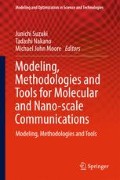Abstract
Nano-technology is rapidly maturing to help realize bio-chemical sensors that can be implanted in human body with integrated transceivers to share symptoms’ data with each other internally to the body, and with outside world.
Access this chapter
Tax calculation will be finalised at checkout
Purchases are for personal use only
References
Ahmad A (2013) A scalable human body modeling technique for networkable implants. In: Proceedings of the 9th international conference on body area networks, Boston MA, September–October 2013
Sarkar TK, Ji Z, Kim K, Medouri A, Salazar-Palma M (2003) A survey of various propagation models for mobile communication. Antennas Propag Mag IEEE 45(3):51–82
Chen AM, Rao RR (1998) On tractable wireless channel models. In: The ninth IEEE international symposium on personal, indoor and mobile radio communications, 1998, vol 2, pp 825–830
Jensen MA, Wallace JW (2004) A review of antennas and propagation for MIMO wireless communications. IEEE Trans Antennas Propag 52(11)
Schwiebert L, Gupta SKS, Weinmann J (2001) Research challenges in wireless networks of biomedical sensors. In: Proceedings of the 7th annual international conference on Mobile computing and networking, July 2001, Rome, Italy, pp 151–165
Heetderks WJ (1988) RF powering of millimeter- and submillimeter-sized neural prosthetic implants. IEEE Trans Biomed Eng 35(5):323–327
Wegmueller MS, Kuhn A, Froehlich J, Oberle M, Felber N, Kuster N, Wolfgang F (2007) An attempt to model the human body as a communication channel. IEEE Trans Biomed Eng 54(10):1851–1857
Gupta SKS, Lalwani S, Prakash Y, Elsharawy E, Schwiebert L (2003) Towards a propagation model for wireless biomedical applications. IEEE international conference on communications, 2003. ICC ‘03, vol 3, 11–15 May 2003, pp 1993–1997
Kwak K-S, Ullah S, Ullah N (2010) An overview of IEEE 802.15.6 standard. In: 2010 3rd international symposium on applied sciences in biomedical and communication technologies (ISABEL), 7–10 November 2010, pp 1–6
De Santis V, Feliziani M (2011) Intra-body channel characterization of medical implant devices. In: EMC Europe 2011 York, 26–30 September 2011, pp 816–819
Tayamachi T, Wang Q, Wang J (2007) Transmission characteristic analysis for UWB body area communications. In: International symposium on electromagnetic compatibility, 2007. EMC 2007, 23–26 October 2007, pp 75–78
Galluccio L, Melodiay T, Palazzo S, Santagati GE (2012) Challenges and implications of using ultrasonic communications in intra-body area networks. In: Proceedings of the 9th annual conference on wireless on-demand network systems and services (WONS), pp 182–189
Geng Y, Wan Y, He J, Pahlavan K (2013) An empirical channel model for the effect of human body on ray tracing. In: 2013 IEEE 24th international symposium on personal indoor and mobile radio communications (PIMRC). IEEE, pp 47–52
Hasler N, Stoll C, Sunkel M, Rosenhahn B, Seidel H-P (2009) A statistical model of human pose and body shape. In: EUROGRAPHICS 2009, vol 28, no 2
Yazdandoost KY (2009) Channel model for body area network (BAN). In: IEEE P802.15–08-0780-09-0006, April 27, 2009
Gabriel C, Gabriely S, Corthout E (1996) The dielectric properties of biological tissues: I. Literature survey. Phys Med Biol 41:2231–2249
Paradiso JA, Starner T (2005) Energy scavenging for mobile and wireless electronics. Pervasive Comput IEEE 4(1):18–27. doi:10.1109/MPRV.2005.9
Wu X, Ma L, Huang KS, Gao Y, Chen Z (2005) Generic-model based human-body modeling. In: Entertainment computing ICEC 2005, Lecture notes in computer science, vol 3711, pp 203–214
Hagedorn J, Sayrafian-Pour K, Yang W-B, Terill JE (2015) (NIST staff), Visualization of body area networks. http://www.nist.gov/itl/math/hpcvg/ban.cfm. Accessed 12 Feb 2015
Author information
Authors and Affiliations
Corresponding author
Editor information
Editors and Affiliations
Rights and permissions
Copyright information
© 2017 Springer International Publishing AG
About this chapter
Cite this chapter
Ahmad, A. (2017). Digital Body. In: Suzuki, J., Nakano, T., Moore, M. (eds) Modeling, Methodologies and Tools for Molecular and Nano-scale Communications. Modeling and Optimization in Science and Technologies, vol 9. Springer, Cham. https://doi.org/10.1007/978-3-319-50688-3_24
Download citation
DOI: https://doi.org/10.1007/978-3-319-50688-3_24
Published:
Publisher Name: Springer, Cham
Print ISBN: 978-3-319-50686-9
Online ISBN: 978-3-319-50688-3
eBook Packages: EngineeringEngineering (R0)

